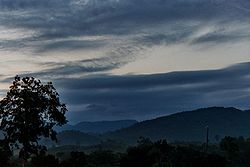- Dawn
-
Dawn is the time that marks the beginning of the twilight before sunrise. It is recognized by the presence of weak sunlight, while the sun itself is still below the horizon. Dawn should not be confused with sunrise, which is the moment when the leading edge of the sun itself appears above the horizon.
The duration of the twilight period between dawn and sunrise varies greatly depending on the observer's latitude, from a few minutes in equatorial regions to many hours in polar regions. Dawn may easily be determined by observing a thread. When the color of a thread can be determined, changing from black to the thread's distinctive color, the 'crack of dawn' has occurred. This same measure of ambient light can be used to determine, conversely, the instant of dusk.
Technical definitions
There are also more technical definitions of dawn, including the following:
- Astronomical dawn
- the moment after which the sky is no longer completely dark; formally defined as the time at which the sun is 18 degrees below the horizon in the morning.[1]
- Nautical dawn
- the time at which there is enough sunlight for the horizon and some objects to be distinguishable; formally, when the sun is 12 degrees below the horizon in the morning.[1]
- Civil dawn
- that time at which there is enough light for objects to be distinguishable, so that outdoor activities can commence; formally, when the sun is 6 degrees below the horizon in the morning.[1]
- Solar dawn
- that time at which the leading edge of the sun reaches the horizon in the morning, ignoring the effect of atmospheric refraction.
Causes and effects
During dawn (and dusk) it is usually possible (provided that the sky is cloud-free) to see approximately in which direction the sun is (though it's below the horizon).
Though it is possible to localize the direction of the sun during astronomical dawn and dusk, people in general experience astronomical dawn and dusk as night, even without clouds. Zenith is dark and more than just the brightest shining stars can be seen (except low above the horizon in the direction of the sun).
At civil dawn there is no darkness in any direction, nor at zenith. The sky is bright, even when cloudy. In mid and northern Scandinavia, summer nights never get any further than to civil dusk or dawn. This period of "bright nights" is longer at higher latitudes (further north).
North of the polar circle (at 66°30′ N) the sun does not set at all at the summer solstice. The period of no sunset is longer closer to the North Pole. The angular radius of the polar circle is equal to the angle between the plane of Earth's equator and that of the ecliptic. At true solar noon at London (latitude 51°30′ N), the sun is at an angle of (90 - 51,5 =) 38.5 degrees above the horizon at the equinoxes. At winter solstice the "sun height" (solar elevation angle) is (38.5 - 23.5 =) 15.0 degrees above horizon. At summer solstice the "sun height" is instead (38.5 + 23.5 =) 62 degrees above horizon.
Nautical dawn is more difficult to describe. Near the summer solstice, latitudes higher than 54°30′ get no darker than nautical dawn/dusk; the "darkness of the night" varies greatly in these latitudes.
But while, for instance, Glasgow, Scotland at 56°00′ N and Copenhagen, Denmark at 55°45′ N get a few hours of "night feeling", Oslo, Norway at 60°00′ N and Stockholm, Sweden at 59°20′ N seems very bright all the time the sun is below the horizon. This may call for a different classification of dawn and dusk terminology for more practical use than astronomy. When the sun gets 9.0 to 9.5 degrees below the horizon (at summer solstice this is at latitudes 57°30′–57°00′), zenith gets dark even on cloud-free nights (if there is no full moon); more than just the brightest shining stars are clearly visible in a large majority of the sky.
All phases of dawn and dusk are shortest at the equator, where the sun at equinox rises and sets at a right angle to the horizon. Civil, nautical, and astronomical dawn and dusk last only 24 minutes each.
Dawn and dusk times are fastest at the times around the equinoxes and slowest at summer and winter solstices on all places on the earth.
At the poles, the sun rises at the spring equinox and sets at the autumn equinox, with a long period of dawn/dusk, lasting for a few weeks .
Mythology
Many Indo-European mythologies have a goddess of dawn, separate from the male Solar deity, her name deriving from PIE *h2ausos-, derivations of which include Greek Eos, Roman Aurora, Indian Ushas, Slavic Zornitsa and possibly a Germanic *Austrōn- (whence Easter). The Hindu dawn deity Aruṇa is male. In Native American mythology, Anpao is an entity with two faces.
Religion
In Islam, dawn (Arabic fajr) is the time of the first prayer of the day, and the beginning of the daily fast during Ramadan.
See also
References
External links
Parts of a day  Related articles: Blue hour · Golden hour · Terminator · Forenoon · Afternoon · Daytime · Daylight · Midnight sunCategories:
Related articles: Blue hour · Golden hour · Terminator · Forenoon · Afternoon · Daytime · Daylight · Midnight sunCategories:- Earth phenomena
- Night
- Parts of a day
Wikimedia Foundation. 2010.





